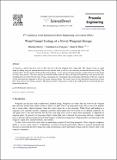Wind tunnel testing of a novel wingsuit design
Author(s)
Blair, Kim B.; Berry, Michael S.; Las Fargeas, Jonathan C.
DownloadBerry-2010-Wind tunnel testing.pdf (542.3Kb)
PUBLISHER_POLICY
Publisher Policy
Article is made available in accordance with the publisher's policy and may be subject to US copyright law. Please refer to the publisher's site for terms of use.
Terms of use
Metadata
Show full item recordAbstract
A wingsuit is a special suit that is worn to allow the user to fly after jumping off of a high cliff. The wingsuit creates an airfoil shape by adding wings of material between the arms and the sides as well as a tail consisting of material between the legs. The wingsuit allows for the creation of lift and thus human flying. A new and novel wingsuit design is proposed based on the design of a delta wing aircraft. This new wingsuit has material leading from the side of the head and connecting to the top of the arms, extending the area of the forward wing. Using a mannequin in a wind tunnel, the aerodynamic performance of the new wingsuit will be measured and compared to that of the current wingsuit design. The results show that the redesigned wingsuit had a lower lift-to-drag ratio in most testing scenarios. The decrease in lift-to-drag ratio was due to the combination of an increased lift and a higher increased drag.
Date issued
2010-06Department
Massachusetts Institute of Technology. Department of Mechanical EngineeringJournal
Procedia Engineering
Publisher
Elsevier
Citation
Berry, Michael, Jonathan Las Fargeas, and Kim B. Blair. “Wind Tunnel Testing of a Novel Wingsuit Design.” Procedia Engineering 2, no. 2 (June 2010): 2735–2740.
Version: Final published version
ISSN
18777058